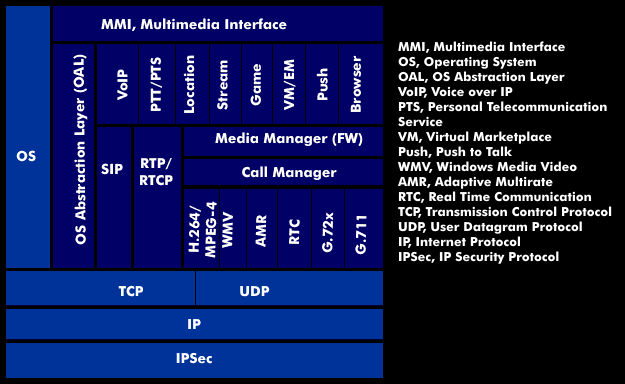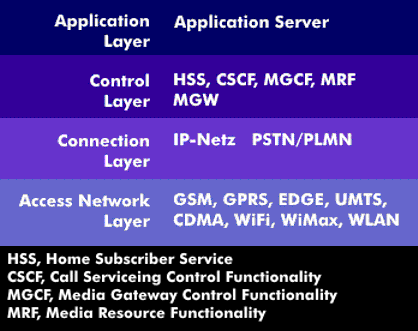IP multimedia subsystem (NGN) (IMS)
One step toward convergence of networks and services, as envisaged by the Next Generation Network( NGN), is the transition from a network access technology to a service access technology. The concept used for this is called IPMultimedia Subsystem ( IMS), which separates the control functions from the transport functions and combines fixed networks, cable networks, mobile networks, WLANs and WiMAX into a flexible infrastructure via which new applications can be introduced. For example, Internet television( IPTV), Internet telephony( VoIP), video conferencing, video games with multiple participants, Rich Communication Suite - Enhanced( RCS-e), etc.
For this purpose, the IMS system provides its own standards and a layer model that consistently divides the telecommunications network into layers for the access network, switching network with the session layer and the application.
IP Multimedia Subsystem as an integration platform
IMS equally forms a central integration platform for the control of mobile services, customer management and accounting for mobile services based on the IP protocol. The central component of the IP Multimedia Subsystem is the Call Session Control Function( CSCF), which initiates, coordinates and monitors multimedia sessions and thus forms the prerequisite for multimedia communication of different services between different networks. Other core components are the MediaGateway Control Function (MGCF) for Internetworking at the call control level, the Media Gateway( MGW), the Breakout Gateway Control Function (BGCF) and the Multimedia Resource Function Controller (MRFC). For communication between the network elements and the users, IMS uses the Session Initiation Protocol( SIP), known from Internet telephony.
The IMS concept, developed by TISPAN, a sub-organization of ETSI, is supported by the 3rd Generation Partnership Project( 3GPP) and the UMTS Forum, and is intended to provide a broad application scenario for individual and group communications. This applies equally to real-time and non-real-time applications as well as to triple-play services.
The IMS multimedia switching technology
The IMS standard describes a multimedia switching technology for packet-switched networks and various access technologies in mobile communications such as UMTS, EDGE, General Packet Radio Service( GPRS) or WLAN. Mobile network operators can use it to implement numerous voice, multimedia and data services using the IP protocol and the SIP protocol. Examples of IMS applications include multimedia and video conferencing as well as push-to-talk or instant messaging.
Alongside the convergence of voice, video and data is the convergence of fixed networks with mobile networks. Thanks to this convergence, mobile triple-play services are possible. In addition, IMS allows the establishment of multimedia connections and switching between a wide variety of services without media discontinuity.
IMS describes the functions of the network elements and the interfaces between them. The individual network elements perform various functions: the application server provides services, the call processing elements handle signaling, database systems store user data, media servers play announcements, and gateways connect the various access networks.


